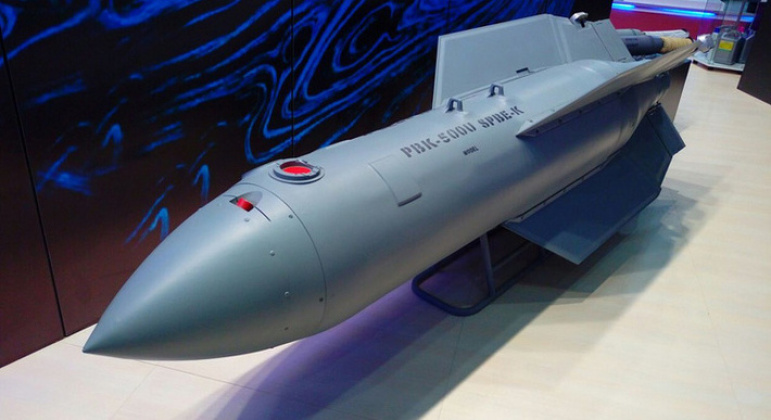Y
YabbaDabbaDoo
Banned
Well-known member
I'd say it's curtains for Ukraine VERY soon...........

The Russian Air Force has begun deploy guided glide bombs in significant quantities to complement the growing firepower being laid down by artillery and missile assets. Ukrainian Air Force spokesman Colonel Yuri Ignat warned on May 2 regarding the threat these weapons posed: “Those bombs can fly about 70 kilometres (about 43 miles) and they may target the facilities of critical infrastructure and we cannot counter this type of ammunition.
Our air defence is inefficient against the bombs themselves but we should rather try to down the Su-34 [strike fighter] carriers of this ammunition.” Although Russia was previously thought to have had only a limited number of guided bombs in its inventory, inventories have reportedly expanded significantly since February 2022 as the defence sector has significantly increased production of a wide range of munition types. This has been done to meet the requirements of both the war in Ukraine and of defending against NATO’s expanding presence near Russian territory on multiple fronts.
Guided glide bombs are not only far more precise, allowing aircraft to strike many more targets each time they brave Ukrainian air defences, but their ability to fly around 70 kilometres to their targets also significantly reduces the risks of being shot down compared to flying directly over a target using traditional gravity bombs. Ukraine’s Soviet built S-300 air defence systems are restricted to ranges of around 100km or less depending on the variant, in contrast to modern variants of the S-300 built in Russia today which have 400km ranges, meaning Russian aircraft have some freedom to deploy glide bombs without a high risk of being hit.
Russian Drel Guided Glide Bomb
Warnings have continued to grow that Ukraine’s air defence network is increasingly at risk of becoming depleted beyond hopes of replenishment, with Pentagon officials assessing that defences assigned to protect forces on the frontlines would “be completely reduced” by May 23. As early as November 2022 Colonel Yuri Ignat told the London based Financial Times that the inability to procure additional missiles for S-300 and BuK systems would soon begin to limit Ukrainian forces’ ability to properly intercept incoming Russian projectiles. Russian attacks singling out air defence assets, and particularly S-300s, for destruction, has only exacerbated the issue. On May 1 alongside a missile strike that destroyed 200 tons of Ukrainian munitions in Donetsk, Russian forces destroyed two missile divisions’ worth of S-300 air defence systems in an attack on Ukrainian depots in Pavlograd in the Dnepropetrovsk Region. This followed a successful air strike that destroyed four missile launchers for Ukrainian S-300s on April 27. With Ukraine having inherited the largest air defence network in Europe when the Soviet Union disintegrated, the much smaller Western stocks of air defence assets and productive capacities for such systems means replenishment remains highly unlikely. The result is expected to be much greater freedom of action for the Russian Air Force as Ukraine’s ability to maintain air denial continues to quickly decline – a development only made more dangerous for Ukraine by the apparent abundance of guided bombs to equip Russian aircraft such as its Su-34 strike fighters.

The Russian Air Force has begun deploy guided glide bombs in significant quantities to complement the growing firepower being laid down by artillery and missile assets. Ukrainian Air Force spokesman Colonel Yuri Ignat warned on May 2 regarding the threat these weapons posed: “Those bombs can fly about 70 kilometres (about 43 miles) and they may target the facilities of critical infrastructure and we cannot counter this type of ammunition.
Our air defence is inefficient against the bombs themselves but we should rather try to down the Su-34 [strike fighter] carriers of this ammunition.” Although Russia was previously thought to have had only a limited number of guided bombs in its inventory, inventories have reportedly expanded significantly since February 2022 as the defence sector has significantly increased production of a wide range of munition types. This has been done to meet the requirements of both the war in Ukraine and of defending against NATO’s expanding presence near Russian territory on multiple fronts.
Guided glide bombs are not only far more precise, allowing aircraft to strike many more targets each time they brave Ukrainian air defences, but their ability to fly around 70 kilometres to their targets also significantly reduces the risks of being shot down compared to flying directly over a target using traditional gravity bombs. Ukraine’s Soviet built S-300 air defence systems are restricted to ranges of around 100km or less depending on the variant, in contrast to modern variants of the S-300 built in Russia today which have 400km ranges, meaning Russian aircraft have some freedom to deploy glide bombs without a high risk of being hit.
Russian Drel Guided Glide Bomb
Warnings have continued to grow that Ukraine’s air defence network is increasingly at risk of becoming depleted beyond hopes of replenishment, with Pentagon officials assessing that defences assigned to protect forces on the frontlines would “be completely reduced” by May 23. As early as November 2022 Colonel Yuri Ignat told the London based Financial Times that the inability to procure additional missiles for S-300 and BuK systems would soon begin to limit Ukrainian forces’ ability to properly intercept incoming Russian projectiles. Russian attacks singling out air defence assets, and particularly S-300s, for destruction, has only exacerbated the issue. On May 1 alongside a missile strike that destroyed 200 tons of Ukrainian munitions in Donetsk, Russian forces destroyed two missile divisions’ worth of S-300 air defence systems in an attack on Ukrainian depots in Pavlograd in the Dnepropetrovsk Region. This followed a successful air strike that destroyed four missile launchers for Ukrainian S-300s on April 27. With Ukraine having inherited the largest air defence network in Europe when the Soviet Union disintegrated, the much smaller Western stocks of air defence assets and productive capacities for such systems means replenishment remains highly unlikely. The result is expected to be much greater freedom of action for the Russian Air Force as Ukraine’s ability to maintain air denial continues to quickly decline – a development only made more dangerous for Ukraine by the apparent abundance of guided bombs to equip Russian aircraft such as its Su-34 strike fighters.



